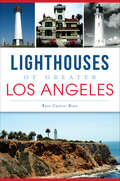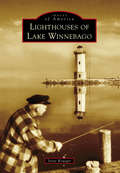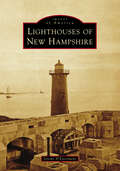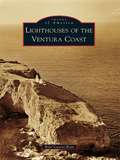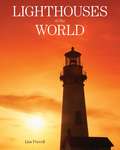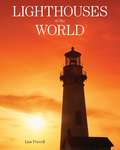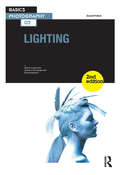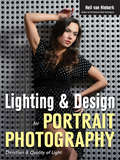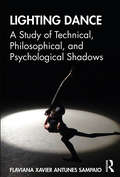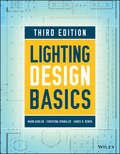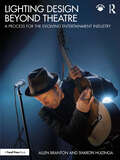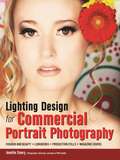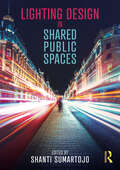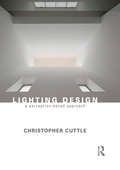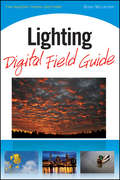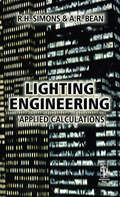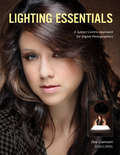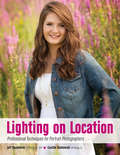- Table View
- List View
Lighthouses of Greater Los Angeles (Landmarks)
by Rose Castro-BranDespite news of shipwrecks along California's dangerous coastline, a burgeoning maritime trade came to what would become the ports of Los Angeles and Long Beach. The shipping complex became the nation's busiest, in part because of the bright navigation lights that enabled reliable access for early vessels. In 1874, sister lighthouses Point Fermin and Point Hueneme were lit on the same day, followed by the Los Angeles Harbor Lighthouse in 1913. Nicknamed the "Hollywood Lighthouse" for its frequent use in movies, in 1926, Point Vicente was established to light the Palos Verdes Peninsula. Today, they are joined by the Anacapa Island Light Station, Long Beach Light and the private aid to navigation, Lions Lighthouse for Sight. Together with the U.S. Coast Guard, these historic beacons continue to illuminate and protect the coast of Greater Los Angeles. Join author Rose Castro-Bran as she explores their storied history.
Lighthouses of Lake Winnebago (Images of America)
by Steve KruegerLake Winnebago has a rich history as a major settlement area in the Midwest, and a significant part of its times gone by involved water transportation for both commerce and passengers. Throughout its history, the 137,700-acre lake has been home to six current lighthouses, two navigation lanterns that have long disappeared from the landscape, and one that was scheduled to be built but never came to fruition. History has forgotten a few, but Lighthouses of Lake Winnebago will take you on a trip around the largest lake within Wisconsin’s borders and show you the familiar, while introducing you to the forgotten.
Lighthouses of New Hampshire (Images of America)
by Jeremy D'EntremontNew Hampshire's seacoast may be just 18 miles long, but what it lacks in length, it makes up for with centuries of fascinating maritime history. Portsmouth developed along the banks of the Piscataqua River to become the state's colonial capital and a center of trade and shipbuilding. Portsmouth Harbor's 1771 lighthouse was the first lighthouse established in the American colonies north of Boston. A few miles offshore, Native Americans were fishing and hunting at the archipelago known as the Isles of Shoals for centuries before the islands were developed by European fishermen and settlers in the 1600s, and a lighthouse was established at the southernmost island in 1821. Inland, three wooden lighthouses were built on Lake Sunapee in the late 1800s to guide steamships full of vacationers to their destinations around the lake. All of these locations have stories to tell of dedicated keepers and their families, shipwrecks, rescues, and much more.
Lighthouses of the Ventura Coast
by Rose Castro-BranThe Ventura County coast has been illuminated for more than a century by three distinctive lighthouses, united in their mission of warning mariners of coastal hazards and guiding ships to safe passage. Port Hueneme's original 1874 Victorian Stick Style lighthouse stood sentry until it was replaced in 1940 by the still-standing art moderne structure, which guards the only deepwater port on the California coast between San Francisco and San Pedro. The Anacapa Island Light, a cylindrical brick structure in the Channel Islands lit in 1932, was the last new lighthouse on the West Coast. Ventura, originally dubbed San Buenaventura by Fr. Junipero Serra in 1782, extends its "good fortune" to the steamers, warships, tankers, and other craft guided to safety by these navigation beacons.
Lighthouses of the World
by Lisa PurcellFrom ancient times until the present, lighthouses have symbolized safety, homecoming, and the seafaring way of life. Lighthouses of the World provides gorgeous full-color photos showcasing lighthouses from around the world. From the Barnegat Lighthouse on Long Beach Island, to the ancient Kõpu Lighthouse in Estonia (first constructed in 1531), Lighthouses of the World traverses continents in order to provide stunning color photography and illustration showing the many different lighthouses that man has constructed over the centuries.
Lighthouses of the World: 130 World Wonders Pictured Inside
by Lisa PurcellReaders say it best: "fascinating book" with "beautiful photos" and "information regarding all kinds of light houses"From ancient times until the present, lighthouses have symbolized safety, homecoming, and the seafaring way of life. Lighthouses of the World provides gorgeous full-color photos showcasing lighthouses from around the world. From the Barnegat Lighthouse on Long Beach Island, to the ancient Kõpu Lighthouse in Estonia (first constructed in 1531), Lighthouses of the World traverses continents in order to provide stunning color photography and illustration showing the many different lighthouses that man has constructed over the centuries.
Lighting
by David PräkelUnderstanding light is fundamental to good photography. How any image is lit will change how the viewer sees and interprets the content. The second edition of Lighting teaches the theory and background of how light works, the different types of light and the rules it obeys. The book gives guidance on how to measure, control and use light for the best photographic exposure. With new images and case studies, this edition encourages a bolder and more innovative approach to the use of light in photography.
Lighting & Design for Portrait Photography
by Neil Van NiekerkSome photographers make portraits that we can’t take our eyes off of. These images create mood, evoke emotion, and pique our curiosity. They have that certain something that other portraits seem to lack. These rare images are memorable-the kind of shots that clients want and photographers strive to emulate. These portraits are technically precise and have style. Neil van Niekerk is a big name in the portrait and wedding photography industry. His masterful photographs get a reaction, and he’s devoted to helping others create compelling portraits for their clients. In this book, van Niekerk shows readers strategies for creating a wide range of portrait looks (romantic, fun, sweet, dramatic, glamorous, or moody) in lackluster, middle-of-nowhere locales, small home studios, big expanses, and even on rooftops. Starting with traditional lighting and posing strategies and moving through "spicier” varieties, he shows readers how integrating specialized lighting (rim lighting, backlighting, flare, and low-key lighting-using natural light and artificial sources) and compositional approaches (shallow depth of field, lens compression, and unorthodox perspectives) into their creative approach can allow them to take full creative control over their portrait-taking process so that they’re able to deliver incredible shots of their clients in any photographic conditions.
Lighting & Design for Portrait Photography
by Neil Van NiekerkSome photographers make portraits that we can't take our eyes off of. These images create mood, evoke emotion, and pique our curiosity. They have that certain something that other portraits seem to lack. These rare images are memorable-the kind of shots that clients want and photographers strive to emulate. These portraits are technically precise and have style.Neil van Niekerk is a big name in the portrait and wedding photography industry. His masterful photographs get a reaction, and he's devoted to helping others create compelling portraits for their clients. In this book, van Niekerk shows readers strategies for creating a wide range of portrait looks (romantic, fun, sweet, dramatic, glamorous, or moody) in lackluster, middle-of-nowhere locales, small home studios, big expanses, and even on rooftops. Starting with traditional lighting and posing strategies and moving through "spicier" varieties, he shows readers how integrating specialized lighting (rim lighting, backlighting, flare, and low-key lighting-using natural light and artificial sources) and compositional approaches (shallow depth of field, lens compression, and unorthodox perspectives) into their creative approach can allow them to take full creative control over their portrait-taking process so that they're able to deliver incredible shots of their clients in any photographic conditions.
Lighting Dance: A Study of Technical, Philosophical, and Psychological Shadows
by Flaviana Xavier SampaioLighting Dance pioneers the discussion of the ability of lighting design to foreground shadow in dance performances. Through a series of experiments integrating light, shadow, and improvised dance movement, it highlights and analyses what it advances as an innovative expression of shadow in dance as an alternative to more conventional approaches to lighting design. Different art forms, such as painting, film, and dance pieces from Loie Fuller, the Russell Maliphant Dance Company, Elevenplay, Pilobolus, and the Tao Dance Theater served to inspire and contextualise the study. From lighting to psychology, from reviews to academic books, shadows are examined as a symbolic and manipulative entity. The book also presents the dance solo Sombreiro, which was created to echo the experiments with light, shadow, and movement aligned to an interpretation of cultural shadow (Jung 1954, in Samuels, Shorter, and Plaut 1986; Casement 2006; Ramos 2004; Stein 2004; and others). The historical development of lighting within dance practices is also outlined, providing a valuable resource for lighting designers, dance practitioners, and theatre goers interested in the visuality of dance performances.
Lighting Design Basics
by Mark Karlen James R. Benya Christina SpanglerThe essential book of lighting for professional designers, now updated and revisedProviding the fundamental information new designers need to succeed in a concise, highly visual format, the Second Edition of Lighting Design Basics presents realistic goals that can be used as a guide to create simple yet impressive lighting designs and when collaborating with professional designers on more complex projects.Drawing on real-world case studies-- from kitchens to doctors' offices--the book is packed with attractive, helpful illustrations, making it an invaluable resource for students, as well as interior designers and architects studying for professional licensing exams.Authored by leading lighting designers with decades of experience Offers straightforward coverage of lighting concepts and techniques Contains design scenarios for more than twenty different types of spaces Lighting is a basic, yet difficult-to-master element of interior design. Lightning Design Basics changes that, putting the power to create in the hands of the designer.
Lighting Design Basics
by Mark Karlen James R. Benya Christina SpanglerA visual, real-world guide to professional lighting design Lighting Design Basics is the essential guide to this basic, but difficult-to-master aspect of interior design. Offering fundamental concepts and prescriptive techniques in a highly visual format, this book provides clear, practical guidance on utilizing the latest in lighting techniques and technology to showcase a space without sacrificing utility. Covering more than 25 different design scenarios with in-depth rationale for proposed solutions, this book provides insightful distribution diagrams, floor plans, and details for lighting installation and construction. Real-world case studies illustrate lighting design in residential, commercial, healthcare, education, and hospitality settings, and skill-building exercises offer practice for real-world projects as well as NCIDQ and NCARB exam preparation. This new third edition includes new instructor support materials, coverage of computer calculation software, and in-depth discussion on the latest in LED lighting. Lighting is changing, both in the technology itself, and in the way a designer must approach it. This book provides immersive instruction through real-world settings, and practical guidance suited for immediate application in everyday projects. Get up-to-date on the latest methods and technology for lighting design Examine more than 25 design scenarios for different types of spaces Complete exercises to hone your skills or prepare for the NCIDQ or NCARB Create simple lighting designs and collaborate with architects on complex projects Lighting can make or break a space. Improper lighting lends a space an uncomfortable feel, can induce headaches or eyestrain, and can even be hazardous—but thoughtfully designed and executed lighting adds that extra element so often missing from typical spaces. Lighting Design Basics shows you how to elevate any space through the fundamental tools and concepts of professional lighting design.
Lighting Design Basics
by Mark Karlen Christina SpanglerLIGHTING DESIGN BASICS AN AUTHORITATIVE INTRODUCTION TO PROFESSIONAL LIGHTING DESIGN FOR ARCHITECTS, INTERIOR DESIGNERS, AND ENGINEERS Lighting is an essential component of any designed space, yet it is one of the most difficult right. Lighting Design Basics, 4th Edition provides a fundamental grounding in architectural lighting concepts, processes, and techniques that every student must master. The book offers a carefuly balanced combination of design and technology instruction and provides a great deal of graphic information, complete with plan, section, and three-dimensional drawings. The authors examine over 25 different design scenarios with in-depth rationales for proposed solutions, insightful distribution diagrams, floor plans, and details for lighting installation and construction. Immersive instruction on real-world settings accompanies practical guidance suitable for immediate application in everyday projects. Lighting can make or break any space, and design choices impact the cost and comfort of the building over the long term. <P><P>Lighting Design Basics provides a critical foundation and prescriptive techniques to help future architects and interior designers make smart design choices. This new edition provides readers with: A new chapter, entitled Light and Health, covering the physiological aspects of lighting design Updated LED technical content with coverage of light sources, luminaires, controls, quantity and quality of light, color rendition, and calculation software tutorials Explorations of industry codes and additional material on sustainable practices Thorough discussions of lighting in residences, workspaces, educational facilities, healthcare spaces, retail stores, and hospitality environments The basic skills required to become competent in the field, and prepare for the NCIDQ and NCARB exams Designed for undergraduate students in architecture and interior design, the latest edition of Lighting Design Basics is also valuable for working professionals in both fields who want to refresh their skills in lighting design and/or lighting technology
Lighting Design Basics
by Mark Karlen James BenyaLighting is a basic, yet difficult-to-master, element of interior design, and Lighting Design Basics provides the information you need in a concise, highly visual format. Two leading designers, both with decades of experience, offer straightforward coverage of concepts and techniques, and present realistic goals you can use as guides to creating simple, typical lighting designs and when collaborating with professional designers on more complex projects. Design scenarios for more than twenty different spaces illustrate real-world case studies for illuminating residential and commercial spaces, from kitchens to doctors' offices. Each scenario includes an in-depth rationale for the proposed solution, insightful lighting distribution diagrams, floor plans, and details for lighting installation and construction. In addition, exercises allow you to develop lighting design skills in preparation for working on actual projects, as well as the NCIDQ and NCARB exams. Packed with informative illustrations, Lighting Design Basics is an invaluable resource for students, as well as interior designers and architects studying for professional licensing exams.
Lighting Design Beyond Theatre: A Process for the Evolving Entertainment Industry
by Allen Branton Sharon HuizingaLighting Design Beyond Theatre provides a step-by-step design process for live event lighting outside of traditional theatre, dance, and opera, including concerts and tours, awards shows, sporting events, benefits, comedy shows, corporate events, fashion shows, political events, and more.This book introduces the origins and history of live events, establishes a shared practice for lighting designers working in live event design, compares and contrasts where lighting design process for theatre, dance, and opera differs from lighting design process for live events, and provides practical considerations and wisdom about navigating the work culture of these events. Containing case studies and exercises, the book outlines holistic processes and practices for this career, including building a task list, choosing equipment, incorporating constructive feedback, leadership, the realities of money and client relations, and getting invited back for more job opportunities.This book is written for students of lighting design and emerging lighting designers interested in exploring lighting design outside the traditional theatre industry, as well as instructors teaching lighting design for nontheatrical live events.Lighting Design Beyond Theatre includes access to downloadable materials for instructors and readers to use as a project, following along with the exercises in the book. These materials represent the information available at various steps in a design process for a realized show, from venue and site information to scenic renderings and schedule details. The final light plot and production photos are also included.
Lighting Design for Commercial Portrait Photography
by Jennifer EmeryEffective commercial portraiture is heavily reliant on clean, crisp lighting looks that emphasize color, contrast, contours, and texture to allow viewers of magazines, newspapers, television, and movies to view a product or model/celebrity in a precise and predetermined way that suits the overall marketing campaign and leaves viewers with a specific, conscripted feeling about the product /person being shown. Crafting this type of polished lighting requires absolute proficiency with the tools of the trade, from flash, to beauty lights, to softboxes, to gobos and gels. It also requires thinking outside the box to create lighting with a "hook”--a certain quality that binds the look to the brand identity and can be carried out repeatedly across several advertising campaigns. Whether you are producing album cover art, lingerie shoots for an intimates catalog, or production stills for television shows or movies, Jennifer Emery will give you the technical and creative skill set you need to thrive artistically, work efficiently with models and set designers, and win repeat clients. Beginning with essential strategies for finding and casting talent, paying/trading with that talent, and creating an open dialogue throughout the directorial stages, Jennifer builds a solid foundation from which the artistic concept can spring forth. In the following chapters, she presents text and images that will instruct readers on creating numerous looks/projects, including: (1) Beauty lighting for beauty/cosmetics ads (2) High-Key Lighting for a magazine cover shoot, (3) Lighting groups for a movie/TV poster, (4) Sculpting light for boudoir/lingerie/swimsuit/nude photograph, (5) Working with speedlights/flash for editorial fashion and lifestyle shoots, and (6) Lighting exterior locations for high fashion and fashion editorial work. Armed with these skills, photographers will be able to approach any commercial lighting job with a repertoire of skills, an ability to overcome challenges, and the confidence needed to nail the shot every time.
Lighting Design in Shared Public Spaces
by Shanti SumartojoThis book advocates an approach to lighting design that focuses on how people experience illumination. Lighting Design in Shared Public Spaces contextualises light, dark and lighting design within the settings, sensations, ideas and imaginaries that form our understandings of ourselves and the world around us. The chapters in this collection bring a new perspective to lighting design, arguing for an approach that addresses how lighting is experienced, understood and valued by people. Across a range of new case studies from Australia, Germany, Denmark, and the United Kingdom, the authors account for lighting design’s crucial role in shaping our dynamic and messy experiential worlds. With many turning to innovative ethnographic methodologies, they powerfully demonstrate how feelings of comfort, safety, security, vulnerability, care and well-being can configure in and through how people experience and manipulate light and dark. By focusing on how lighting is improvised, arranged, avoided and composed in relation to the people and things it acts upon, the book advances understandings of lighting design by showing how improved experiences of the built environment can result from more sensitive and context-specific illumination. The book is intended for social scientists who are interested in the lit or sensory world, as well as designers, architects, urban planners and others concerned with how the experience of light, dark and lighting might be both better understood and implemented in our shared public spaces.
Lighting Design: A Perception-Based Approach
by Christopher CuttleBy reading this book, you will develop the skills to perceive a space and its contents in light, and be able to devise a layout of luminaires that will provide that lit appearance. Written by renowned lighting expert Christopher (Kit) Cuttle, the book: explains the difference between vision and perception, which is the distinction between providing lighting to make things visible, and providing it to influence the appearance of everything that is visible; demonstrates how lighting patterns generated by three-dimensional objects interacting with directional lighting are strongly influential upon how the visual perception process enables us to recognize object attributes, such as lightness, colourfulness, texture and gloss; reveals how a designer who understands the role of these lighting patterns in the perceptual process may employ them either to reveal, or to subdue, or to enhance the appearance of selected object attributes by creating appropriate spatial distributions of light; carefully explains calculational techniques and provides easy-to-use spreadsheets, so that layouts of lamps and luminaires are derived that can be relied upon to achieve the required illumination distributions. Practical lighting design involves devising three-dimensional light fields that create luminous hierarchies related to the visual significance of each element within a scene. By providing you with everything you need to develop a design concept - from the understanding of how lighting influences human perceptions of surroundings, through to engineering efficient and effective lighting solutions – Kit Cuttle instills in his readers a new-found confidence in lighting design.
Lighting Digital Field Guide
by Brian MclernonEssential lighting guide for users of compact cameras and dSLRsOne of the most important aspects of photography is lighting, but getting the lighting right is tricky. When should you use flash? Are a camera's automatic settings dependable? Should you use reflectors or diffusers and where do you place them? This handy, portable reference will show you when, where, and how to create and capture perfect light, every time. The book includes a color checker card to help you maintain true color, as well as examples of stunningly-lit photos of people, wildlife, and landscapes to inspire you.Walks you through the essentials of lighting for digital photographyHelps beginning and intermediate photographers leave the safety of automatic settings and confidently control lighting themselvesShows how to evaluate natural light, decide when to use flash, and how and when to use diffusers or reflectorsIncludes a tear-out color checker card to help you maintain true color in your photographsComes in the handy, portable Digital Field Guides size, perfect for camera bagsCreate and capture the perfect lighting every time, with Lighting Digital Field Guide!
Lighting Engineering: Applied Calculations
by R. H. Simons A.R. Bean'Lighting Engineering: Applied Calculations' describes the mathematical background to the calculation techniques used in lighting engineering and links them to the applications with which they are used. The fundamentals of flux and illuminance, colour, measurement and optical design are covered in detail. There are detailed discussions of specific applications, including interior lighting, road lighting, tunnel lighting, floodlighting and emergency lighting. The authors have used their years of experience to provide guidance for common mistakes and useful techniques including worked examples and case studies.The last decade has seen the universal application of personal computers to lighting engineering on a day-to-day basis. Many calculations that were previously impracticable are therefore now easily accessible to any engineer or designer who has access to an appropriate computer program. However, a grasp of the underlying calculation principles is still necessary in order to utilise these technologies to the full. Written by two of the leading authorities on this subject, 'Lighting Engineering' is essential reading for practising lighting engineers, designers and architects, and students in the field of lighting.
Lighting Essentials
by Don GiannattiEncouraging photographers to take a subject-oriented approach to lighting, this manual shows it is possible to make better decisions about both the technical and artistic aspects of lighting. It teaches how to identify qualities the subject possesses that the light will react with and how to use this knowledge to create perfect photographs. Through a variety of amply illustrated shoots, the book explains how to approach each image from the perspective of controlling the subject’s appearance to match the photographer’s vision for the picture. This comprehensive guide covers such topics as the benefits and drawbacks of various lighting tools, the effect of light placement, and controlling lighting ratios. Designed for intermediate-to-advanced photographers, it illustrates techniques for using light as a tool to capture the subject in the best possible manner.
Lighting Essentials
by Don GiannattiEncouraging photographers to take a subject-oriented approach to lighting, this manual shows it is possible to make better decisions about both the technical and artistic aspects of lighting. It teaches how to identify qualities the subject possesses that the light will react with and how to use this knowledge to create perfect photographs. Through a variety of amply illustrated shoots, the book explains how to approach each image from the perspective of controlling the subject's appearance to match the photographer's vision for the picture. This comprehensive guide covers such topics as the benefits and drawbacks of various lighting tools, the effect of light placement, and controlling lighting ratios. Designed for intermediate-to-advanced photographers, it illustrates techniques for using light as a tool to capture the subject in the best possible manner.
Lighting Essentials
by Don GiannattiEncouraging photographers to take a subject-oriented approach to lighting, this manual shows it is possible to make better decisions about both the technical and artistic aspects of lighting. It teaches how to identify qualities the subject possesses that the light will react with and how to use this knowledge to create perfect photographs. Through a variety of amply illustrated shoots, the book explains how to approach each image from the perspective of controlling the subject’s appearance to match the photographer’s vision for the picture. This comprehensive guide covers such topics as the benefits and drawbacks of various lighting tools, the effect of light placement, and controlling lighting ratios. Designed for intermediate-to-advanced photographers, it illustrates techniques for using light as a tool to capture the subject in the best possible manner.
Lighting Essentials
by Don GiannattiEncouraging photographers to take a subject-oriented approach to lighting, this manual shows it is possible to make better decisions about both the technical and artistic aspects of lighting. It teaches how to identify qualities the subject possesses that the light will react with and how to use this knowledge to create perfect photographs. Through a variety of amply illustrated shoots, the book explains how to approach each image from the perspective of controlling the subject's appearance to match the photographer's vision for the picture. This comprehensive guide covers such topics as the benefits and drawbacks of various lighting tools, the effect of light placement, and controlling lighting ratios. Designed for intermediate-to-advanced photographers, it illustrates techniques for using light as a tool to capture the subject in the best possible manner.
Lighting On Location: Professional Techniques For Portrait Photographers
by Jeff Dachowski Carolle DachowskiLocation portraiture offers many advantages. The backgrounds are varied, the surroundings can tell a story about the client, and the setting can help tell the subject’s story. Working on location presents unique challenges, however. Often, the photographer is working in an unfamiliar place in which the lighting is not ideal for portraiture. Light is the very backbone of a good portrait, so the need to manage and modify the light becomes a top priority in the portrait session. The Dachowskis teach you how to harness the light in any scenario--from direct sun, to window light, to fluorescent light, to household lamp light, and even mixed-lighting scenarios--to create correct exposures and believable image color. You’ll learn to restrict and enhance the light, add dramatic highlights and shadows to create dimension, and set the mood in the portrait. With these tips, you’ll learn to handle location portrait challenges with ease and confidence.
